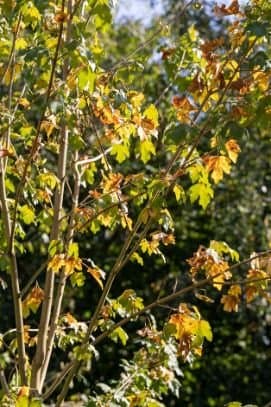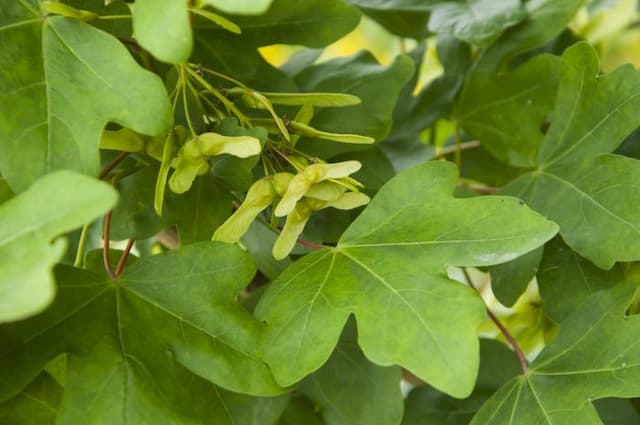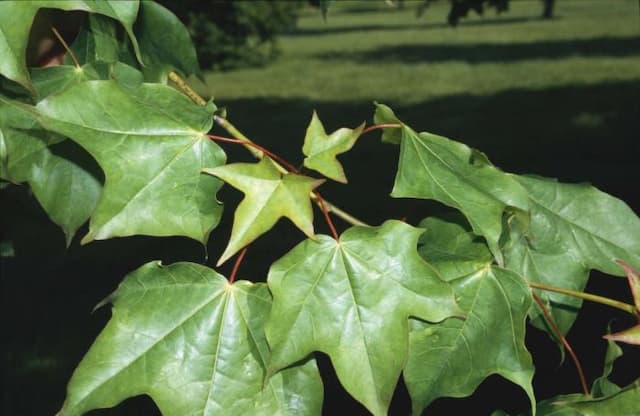Japanese Maple Acer palmatum 'Pink Filigree' (D)

ABOUT
The Japanese maple 'Pink Filigree' is a stunning ornamental plant prized for its intricate and delicate foliage, characterized by an elegant dissected form that creates a lacy appearance. The leaves are the centerpiece of its visual appeal, emerging in spring with a soft pinkish hue that gently matures to a variegated pattern of green with pinkish overtones. Each leaf comprises multiple narrow lobes that spread out like fingers of a hand, contributing to the plant's feathery, finely cut texture. As the seasons transition, the foliage undergoes a dramatic change in color, offering a year-round display of evolving beauty. In the fall, the leaves turn into a vibrant mix of warm colors ranging from golden yellow to orange and deep reds, providing a spectacular autumn show. The leaves appear almost translucent, which is particularly noticeable when backlit by the sun, creating a glowing effect that accentuates the fine tracery of veins. The Japanese maple 'Pink Filigree' has a graceful growth habit with branches that spread outward as much as they ascend, forming an elegant, rounded canopy that adds visual interest to any garden setting. Its branching structure becomes more noticeable in the winter, after the leaves have fallen, revealing an intricate silhouette against the backdrop of the winter sky. Gardeners cherish this cultivar not only for its mesmerizing foliage but also for its adaptability to various garden designs and settings, which makes it a favorite in both traditional and contemporary landscapes. It is an exquisite choice for small garden spaces, patios, and courtyards where its ornate leaves can be appreciated up close. This Japanese maple variant is a true gem among ornamental plants, offering a poetic blend of color, form, and texture throughout the year.
About this plant
 Names
NamesFamily
Aceraceae
Synonyms
Pink Filigree Japanese Maple
Common names
Acer palmatum 'Pink Filigree'
 Toxicity
ToxicityTo humans
The Japanese Maple is generally considered non-toxic to humans. Ingesting any part of this plant is not expected to lead to poisoning or cause harmful symptoms.
To pets
The Japanese Maple is also generally considered non-toxic to pets. It is not known to cause poisoning or adverse health affects if pets ingest parts of this plant.
 Characteristics
CharacteristicsLife cycle
Perennials
Foliage type
Deciduous
Color of leaves
Variegated
Height
6-8 feet (1.8-2.4 meters)
Spread
4-6 feet (1.2-1.8 meters)
Plant type
Shrub
Hardiness zones
5-9
Native area
Japan
Benefits
 General Benefits
General Benefits- Aesthetic Appeal: Acer palmatum 'Pink Filigree' adds a delicate beauty to any garden with its fine, lacey foliage and gentle pink tones.
- Seasonal Interest: This plant provides vibrant seasonal color changes, including a stunning display of fall colors ranging from bright red to deep burgundy.
- Shade Tolerance: Being a Japanese maple, 'Pink Filigree' can thrive in partial shade where many sun-loving plants may struggle.
- Compact Size: It is suitable for smaller gardens or spaces, as it grows more compactly than other maple varieties.
- Versatility in Landscaping: 'Pink Filigree' can be used in a variety of landscaping designs, including as a specimen plant, in container gardens, or as an understory tree.
- Wildlife Attraction: While not its primary benefit, this maple can attract birds and beneficial insects that feed on any pests.
- Low Maintenance: Japanese maples require minimal pruning and care once established, making them ideal for gardeners who prefer less hands-on upkeep.
- Can Improve Property Value: Well-maintained and mature specimens can add to the overall aesthetic of a property, potentially improving its value.
 Medical Properties
Medical PropertiesThis plant is not used for medical purposes.
 Air-purifying Qualities
Air-purifying QualitiesThis plant is not specifically known for air purifying qualities.
 Other Uses
Other Uses- Crafting Bonsai Trees: Acer palmatum, commonly known as Japanese Maple, can be trained as a bonsai, offering a miniature landscape piece that reflects the beauty of nature.
- Photography Backdrops: The delicate and intricately cut leaves of the 'Pink Filigree' variety create a stunning backdrop for photographers seeking a natural and soft pink aesthetic.
- Artistic Inspiration: Artists may use the intricate leaf patterns and colors of the Japanese Maple 'Pink Filigree' for painting or drawing studies in botanical art.
- Fairy Gardens: The miniature scale and picturesque form of the Japanese Maple make it an ideal addition to whimsical fairy gardens.
- Educational Use: Horticulture and botany educators can utilize Japanese Maple 'Pink Filigree' to teach about plant morphology due to its distinct leaf shapes.
- Garden Sculptures: The tree's branches can be trained and pruned to form living sculptures in ornamental gardens.
- Water Feature Accent: Planted beside a pond or waterfall, the cascading form and reflective pink leaves of the Japanese Maple enhance the tranquility of water features.
- Mood Enhancing Environment: The serene appearance of the 'Pink Filigree' Japanese Maple can contribute to creating a calming and restorative outdoor space for therapy or relaxation areas.
- Seasonal Festivities: With its striking autumn colors, the Japanese Maple can be integrated into fall festival decorations or harvest-themed displays.
- Leaf Casting: The distinct leaves of the Japanese Maple can be used for leaf casting projects to create decorative plaques or stepping stones for gardens.
Interesting Facts
 Feng Shui
Feng ShuiThe Japanese Maple is not used in Feng Shui practice.
 Zodiac Sign Compitability
Zodiac Sign CompitabilityThe Japanese Maple is not used in astrology practice.
 Plant Symbolism
Plant Symbolism- Beauty: The delicate and intricate leaves of the Japanese Maple 'Pink Filigree' are a symbol of beauty and aesthetic appreciation, often representing the unique and subtle elegance found in nature.
- Peace: In traditional Japanese culture, maples are often associated with peace and tranquility, echoing the calm, serene landscapes these trees often inhabit.
- Balance: The symmetrical shape of this variety's leaves, along with its balanced growth habit, can represent the idea of harmony and equilibrium in life.
- Change: As a deciduous tree known for its colorful foliage that changes through the seasons, the Japanese Maple 'Pink Filigree' is often seen as a symbol of change and transformation.
- Endurance: Despite their delicate appearance, Japanese Maples are hardy and resilient, symbolizing the ability to endure challenges and adapt to changing conditions.
 Water
WaterJapanese Maple 'Pink Filigree' plants prefer consistently moist soil, so it's essential to establish a regular watering routine. Water the tree deeply once a week, providing about 10 gallons for young trees and up to 20 gallons for more established trees, depending on the weather conditions and soil type. During particularly hot or dry spells, you may need to water twice a week. In contrast, reduce the frequency during cooler months or periods of rain. It’s crucial to avoid waterlogging the soil, as this can lead to root rot, so ensure good drainage is in place.
 Light
LightJapanese Maple 'Pink Filigree' thrives in conditions with dappled sunlight or part shade. They can tolerate full sun in cooler climates but need protection from the intense afternoon sun in warmer areas. The ideal spot offers morning sunlight with shade or filtered light during the afternoon to prevent leaf scorch.
 Temperature
TemperatureJapanese Maple 'Pink Filigree' is hardy and can endure temperatures as low as -20 degrees Fahrenheit, but it's best grown in areas where temperatures range from 60 to 70 degrees Fahrenheit. They can tolerate brief periods of higher temperatures, but prolonged heat above 80 degrees Fahrenheit can stress the plant.
 Pruning
PruningPruning Japanese Maple 'Pink Filigree' is mainly for shaping and removing dead or damaged branches to maintain tree health. The best time to prune is when the tree is dormant, during late fall or winter, avoiding the spring sap flow period. Pruning every 2-3 years is generally adequate, focusing on thinning out crowded areas to improve air circulation.
 Cleaning
CleaningAs needed
 Soil
SoilJapanese Maple 'Pink Filigree' thrives in well-draining, moist soil high in organic matter with a slightly acidic to neutral pH of around 5.5 to 7.0. A mix containing 1/3 peat moss, 1/3 pine bark, and 1/3 coarse sand or perlite is ideal for potting.
 Repotting
RepottingJapanese Maple 'Pink Filigree' should be repotted every 2-3 years, during dormancy in late winter or early spring, into a slightly larger container with fresh soil to prevent root binding.
 Humidity & Misting
Humidity & MistingJapanese Maple 'Pink Filigree' prefers moderate humidity levels; maintaining ambient humidity around 50-60% is beneficial for its growth.
 Suitable locations
Suitable locationsIndoor
Place in bright, indirect light with high humidity.
Outdoor
Shelter from strong winds; partial shade ideal.
Hardiness zone
5-8 USDA.
 Life cycle
Life cycleThe Japanese Maple 'Pink Filigree' begins its life cycle as a seed, which, under appropriate conditions, will germinate and sprout into a seedling. The seedling stage is marked by rapid root and shoot development as it establishes itself. As the plant grows, it enters the vegetative stage, characterized by the development of its unique, delicate pink-tinged lace-like leaves and a branching pattern that gives the shrub its ornamental appeal. After a few years, when mature enough, it enters the reproductive stage, forming inconspicuous flowers that, if pollinated, produce winged samaras (seeds). These seeds, when dispersed, can start new life cycles. The Japanese Maple 'Pink Filigree', being a deciduous tree, also experiences yearly dormancy through the winter months, shedding its leaves and entering a period of rest before resuming growth in the spring.
 Propogation
PropogationPropogation time
Spring-Early Summer
Propogation: Japanese Maple 'Pink Filigree' can be propagated through softwood cuttings taken in late spring or early summer. This method involves selecting a healthy, non-flowering shoot and cutting a 4 to 6 inch (10 to 15 cm) length. The cuttings should have a few leaves left at the top after removing the lower foliage. Dipping the cut end into a rooting hormone can increase the chances of success. The cutting is then placed in a well-draining soil mix and kept in a humid environment with indirect sunlight. Covering the cutting with a plastic bag can help maintain humidity. Roots typically develop within a few weeks, after which the new plant can be gradually acclimated to less humid conditions and eventually transplanted outside.







![Freeman maple [Autumn Blaze]](/_next/image?url=https%3A%2F%2Fplants-admin.emdemapps.com%2Fimages%2Fplants%2F%2Fimages%2F604b575b84d87.png&w=640&q=75)

